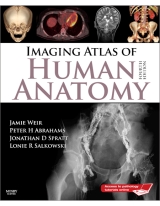Preface to the Fourth edition
Preface to the First edition
Acknowledgements and Dedication
Introduction
1. Head, neck and brain
2. Vertebral column and spinal cord
3. Upper limb
4. Thorax
5. Abdomen and pelvis - Cross sectional
6. Abdomen and pelvis - Non cross sectional
7. Lower limb
8. Nuclear medicine
Index
Imaging Atlas of Human Anatomy, 4th Edition provides a solid foundation for understanding human anatomy. Jamie Weir,
Peter Abrahams, Jonathan D. Spratt, and Lonie Salkowski offer a complete and 3-dimensional view of the structures and
relationships within the body through a variety of imaging modalities. Over 60% new images-showing cross-sectional
views in CT and MRI, nuclear medicine imaging, and more-along with revised legends and labels ensure that you have the
best and most up-to-date visual resource. In addition, you'll get online access to 10 pathology tutorials linking to
additional images for even more complete coverage than ever before (with the opportunity to upgrade to more online
tutorials). In print and online, this atlas will widen your applied and clinical knowledge of human anatomy.
Key Features
Features orientation drawings that support your understanding of different views and orientations in images with tables
of ossification dates for bone development.
Presents the images with number labeling to keep them clean and help with self-testing.
New to this Edition
Features completely revised legends and labels and over 60% new images-cross-sectional views in CT and MRI,
angiography, ultrasound, fetal anatomy, plain film anatomy, nuclear medicine imaging, and more-with better resolution
for the most current anatomical views.
Reflects current radiological and anatomical practice through reorganized chapters on the abdomen and pelvis, including
a new chapter on cross-sectional imaging.
Covers a variety of common and up-to-date modern imaging-including a completely new section on Nuclear Medicine-for a
view of living anatomical structures that enhance your artwork and dissection-based comprehension.
Includes stills of 3-D images to provide a visual understanding of moving images.
Provides online access to 30 pathology tutorials and more than 600 additional pathology images to further develop your
visual memory of anatomical structures and positions.


